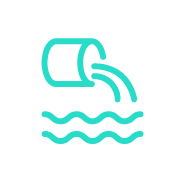Stormwater division
What We Do
The Stormwater Division at MU maintains more than 180 miles of sanitary/combined sewers and 120 miles of storm sewers with 5,700 manholes and 3,200 inlets. That’s enough sewer pipe under Marion to reach from here to Nashville, TN!
The Stormwater Division routinely screens about 380 outfalls (on a 5-year cycle) for illicit discharges or other forms of pollution to keep our area waterways clean and ecologically healthy.
Marion Utilities sweeps every city street twice a year, removing 1,000 tons of sand a debris. This make the streets safer for motorists and helps prevent flooding during heavy rainfall. Additionally, all of our street sweepings are composted, and the compost is given out to the residents for use in their gardens.
What’s in a River?
Report a Polluter or an Illegal Discharge

Combined Sewer Overflows
Sometimes when it rains, raw sewage mixed with stormwater from combined sewers in Marion overflows into the Mississinewa River. This issue is not unique to Marion, but is the norm for hundreds of cities across the Midwest with sewers that we constructed 80+ years ago. Marion Utilities is currently addressing this problem, however, meeting Federal mandates will require significant financial expenditures that will affect the whole city.
We have three kinds of sewers

Storm Sewers
Carry only stormwater runoff.

Sanitary Sewers
Carry only sanitary waste.

Combined Sewers
Carry sanitary waste and stormwater runoff.
The theory behind the combination sewer was that during dry weather it transports sanitary waste to the treatment plant. During wet weather, sanitary waste combined with the influx of stormwater flows to the plant as well, until the sewer reaches capacity. At this point, the combined stormwater and sanitary flow would overflow to the river. This discharge is called a Combined Sewer Overflow (CSO).
Sanitary waste discharged to the river can have a drastic impact on the water quality of the river.
The US EPA recognized the potential danger that CSO’s and other discharges posed to the nations water ways and passed the “Clean Water Act” in 1972. This Act made it illegal to construct combined sewer systems. However, this Act did not require CSO communities to reduce the number of combined sewers contained in their system, therefore communities continued to maintain and operate existing combined sewer systems.
Marion’s sanitary waste collection system consists of approximately 75% combined sewers with 44 miles of sanitary sewer and 132 miles of combined sewers. Some of these sewers are more than 100 years old. It should be noted that previous to the 1940s, there was no Wastewater Treatment Plant in Marion and all sewers eventually discharged directly to the river. At one time the system contained more than 15 CSOs, however through a program of regular maintenance, and sewer separation, the collection system now contains only six combined sewer overflows.
A study completed in 1988 showed that Marion discharged an average of over 1.1 billion gallons of raw sewage mixed with stormwater runoff on an annual basis. With improved maintenance focusing of storage within the system and more than $20 million in sewer separation and system improvements, it is estimated that Marion now overflows less than 183 million gallons in an average year.